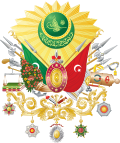The Ottoman Empire was one of the most dominant empires in the Mediterranean region, having lasted ~600 years and controlling much of the Eastern and... 10 KB (1,066 words) - 16:37, 23 April 2024 |
 | The Ottoman Empire, historically and colloquially known as the Turkish Empire, was an imperial realm that spanned much of Southeast Europe, West Asia... 264 KB (27,749 words) - 11:18, 26 April 2024 |
 | The dissolution of the Ottoman Empire (1908–1922) was a period of history of the Ottoman Empire beginning with the Young Turk Revolution and ultimately... 77 KB (9,711 words) - 02:26, 19 April 2024 |
 | The rise of the Ottoman Empire is a period of history that started with the emergence of the Ottoman principality (Turkish: Osmanlı Beyliği) in c. 1299... 76 KB (10,289 words) - 12:11, 24 March 2024 |
In the Ottoman Empire, a millet (Turkish: [millet]; Arabic: مِلَّة) was an independent court of law pertaining to "personal law" under which a confessional... 45 KB (5,477 words) - 20:20, 31 March 2024 |
 | in the Ottoman Empire was a major institution and a significant part of the Ottoman Empire's economy and traditional society. The main sources of slaves... 52 KB (6,279 words) - 00:57, 26 April 2024 |
 | The military of the Ottoman Empire (Turkish: Osmanlı İmparatorluğu'nun silahlı kuvvetleri) was the armed forces of the Ottoman Empire. The Military of... 43 KB (4,434 words) - 15:13, 3 April 2024 |
 | In the Ottoman Empire, women enjoyed a diverse range of rights and were limited in diverse ways depending on the time period, as well as their religion... 48 KB (6,385 words) - 03:26, 25 April 2024 |
 | The Story of the Ottoman Empire, 1300–1923. Basic Books. ISBN 978-0-465-02396-7. Imber, Colin (2009). The Ottoman Empire, 1300–1650: The Structure of... 19 KB (1,992 words) - 17:48, 27 March 2024 |
The Ottoman Empire developed over the years as a despotism[citation needed] with the Sultan as the supreme ruler of a centralized government[citation... 14 KB (1,785 words) - 10:15, 9 April 2024 |
 | the Ottoman Empire's millet system, Christians and Jews were considered dhimmi (meaning "protected") under Ottoman law in exchange for loyalty to the... 24 KB (2,916 words) - 22:31, 21 April 2024 |
 | The language of the court and government of the Ottoman Empire was Ottoman Turkish, but many other languages were in contemporary use in parts of the... 34 KB (3,571 words) - 06:05, 7 February 2024 |
The rise of the Western notion of nationalism in the Ottoman Empire eventually caused the breakdown of the Ottoman millet system. The concept of nationhood... 71 KB (8,711 words) - 00:50, 22 April 2024 |
 | The caliphate of the Ottoman Empire (Ottoman Turkish: خلافت مقامى, romanized: hilâfet makamı, lit. 'office of the caliphate') was the claim of the heads... 29 KB (3,079 words) - 18:44, 15 April 2024 |
 | The Ottoman Empire was governed by different sets of laws during its existence. The Qanun, sultanic law, co-existed with religious law (mainly the Hanafi... 18 KB (2,131 words) - 10:54, 26 April 2024 |
the Ottoman Empire made significant advances in science and technology, in a wide range of fields including mathematics, astronomy and medicine. The Islamic... 37 KB (4,461 words) - 08:29, 3 April 2024 |
 | Mehmed I (redirect from Ottoman sultan Muhammad I) (Ottoman Turkish: چلبی محمد, "the noble-born") or Kirişçi (Greek: Κυριτζής, romanized: Kyritzis, "lord's son"), was the sultan of the Ottoman Empire from... 16 KB (1,837 words) - 13:23, 16 March 2024 |
 | Orhan (redirect from Orhan of the Ottoman Empire) Orhan Ghazi (Ottoman Turkish: اورخان غازی; Turkish: Orhan Gazi, also spelled Orkhan; died 1362) was the second sultan of the Ottoman Empire from 1323/4... 28 KB (3,634 words) - 07:29, 25 April 2024 |
 | Mustafa I (redirect from Mustafa the Saint) twice the sultan of the Ottoman Empire from 22 November 1617 to 26 February 1618, and from 20 May 1622 to 10 September 1623. He was the son of sultan... 15 KB (1,705 words) - 08:18, 24 April 2024 |






